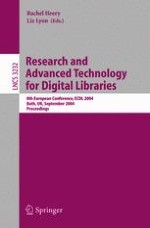2004 | Buch
Research and Advanced Technology for Digital Libraries
8th European Conference, ECDL 2004, Bath, UK, September 12-17, 2004. Proceedings
herausgegeben von: Rachel Heery, Liz Lyon
Verlag: Springer Berlin Heidelberg
Buchreihe : Lecture Notes in Computer Science
Enthalten in: Professional Book Archive
